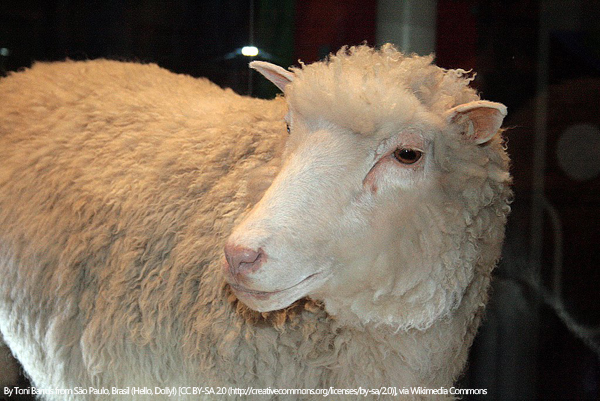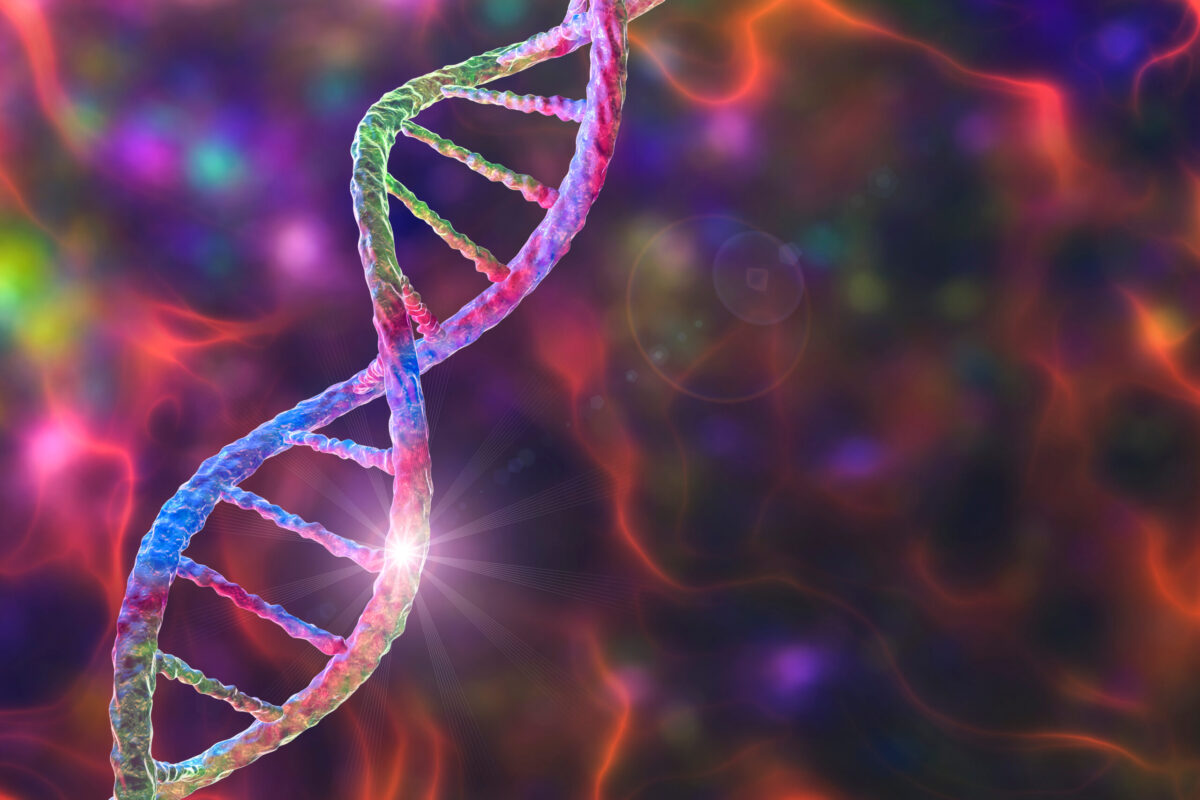Twenty years have passed since Dolly the Sheep became the first mammal to be cloned using an adult cell, but what’s become of the technique since? While cloning receives very little attention today, Dolly’s birth had a profound impact on science and our understanding of genetics. First, let’s look at the history of cloning and what made Dolly arguably the most famous sheep in the world.
Dolly was a female sheep cloned in 1996 by Sir Ian Wilmut, Keith Campbell and their colleagues at the Roslin Institute, University of Edinburgh, Scotland. Using a technique known as somatic cell nuclear transfer, an unfertilized egg taken from a donor sheep was enucleated, and the nucleus collected from the adult mammary cell of another sheep was injected in its place.
Using an electrical pulse, the cell was then stimulated to divide into a multi-celled blastocyst, which was implanted into a surrogate mother sheep and brought to term. When Dolly was born, she was found to be a clone of the nuclear donor sheep, carrying none of the characteristics of her egg-donor mother, or her birth mother.
Interestingly, other animals were cloned before Dolly – including a frog and a mouse – however she become the famous face of the technique. Wilmut and his team were the first to successfully clone an animal using a fully-differentiated somatic cell from an adult mammal. This feat proved that all the genes necessary for life are present in adult cells, and that differentiated cells can be reverted back to an embryonic state under the right conditions.
Dolly produced six lambs over the course of her life, showing that cloned animals remain similarly fertile to animals produced by sexual reproduction. She also developed arthritis at age four, which is not uncommon in sheep.
In early 2003 – just 6 years after her birth – Dolly was euthanized after suffering from a lung disease caused by infection with the Jaagsiekte sheep retrovirus (JSRV). This infection in common among sheep kept indoors, which causes lung cancer in infected animals. While Dolly’s life was just half the average life expectancy for a Finn Dorset sheep, the researchers did not believe that her death had any connection to her being a cloned animal.
At the time of Dolly’s death, some speculated that it must be connected to premature aging processes thought to be associated with cloned animals. Dolly’s telomeres – sections of DNA at the end of chromosomes that are gradually shortened with each cell division – were found to be shorter than expected for her age.
As the DNA used to clone Dolly was collected from a 6-year-old sheep, it was hypothesized that Dolly may have inherited her age from the DNA donor – effectively meaning she was ‘born old.’ This was later disproved however, when researchers found that telomeres were repaired as a result of the cloning process.
Cloning After Dolly
After Dolly was presented to the public in 1997, cloning was hailed as a scientific miracle with many imagining the multitude of potential applications for the technique. Some of the most ethically-complex examples included creating cloned copies of ourselves as a sort of “parts car” for organs, and cloning lost children as replacements.
While this paradigm shift seemed to open up a Pandora’s Box of weird and wonderful possibilities, scientists quickly realized that human cloning would be prohibitively risky. In recognition of the role of environment in human development, researchers also determined that genetics alone would be insufficient to create a human clone with the same personality as the original.
Though many of these potential uses for cloning were almost immediately condemned as unethical and unsafe, some other applications have been realized. Using cloning to bring back extinct species, such as the woolly mammoth – a process known as de-extinction – have so far been unsuccessful, however the technique has been used on endangered species.
In 2003, a hybrid banteng was created using the same somatic cell nuclear transfer cloning technique used to create Dolly. A type of wild cattle, the banteng was created using DNA from cells housed at the San Diego Zoo’s “Frozen Zoo”, and transferred into eggs collected from domesticated cattle.
The resulting embryos were implanted into a female cow surrogate, which brought two hybrid animals to term. While the second-born hybrid was euthanized, the first lived at the San Diego Zoo Safari Park for 7 years, until it died in 2010.
Another even more successful application of cloning technology, is its use in livestock production. Cloning allows for the selection of the most agronomically-important traits in livestock such as cattle, however this technique is mainly used for breeding purposes as opposed to meat destined for consumption.
In 2015, the European Parliament voted to ban cloning livestock for the purposes of meat production, or other animal-derived products. The US Food and Drug Administration (FDA) on the other hand, considers meat from cloned animals to be just as safe as that produced by animals born using conventional breeding practices.
China is currently the leader in livestock cloning, with a company called Boyalife Group announcing their plans to build the world’s largest animal cloning facility. The Chinese company plans to produce 100,000 cattle embryos per year, with the goal of increasing production to 1 million over time.
Dolly’s Contribution To Scientific Knowledge
Since Dolly, numerous animals have been cloned, including pigs, horses and even cats and dogs. Traditional cloning techniques however, remain very inefficient and with newer techniques such as CRISPR gene editing offering the promise of fixing errors in our DNA, interest in cloning has all but fizzled-out.
Dolly’s biggest contribution to science has ironically not been in the field of cloning, but in the generation and use of human stem cells. Dolly’s birth told the scientific community that reprogramming adult mammalian cells was possible, leading to the development of technology capable reverting adult cells back into stem cells.
Dr. Shinya Yamanaka, a stem cell biologist at the University of California, San Francisco, and the director of the Center for iPS Cell Research and Application (CiRA) at Kyoto University in Japan, won the Nobel Prize in 2012 for his project on generating stem cells from adult mouse cells. The technique – which has since been perfected in human cells – creates induced pluripotent stem (iPS) cells capable of differentiating into any tissue type in the body.
Not only do these iPS cells have broad uses in both research, therapeutics, and regenerative medicine, but they have also reduced the demand for embryonic stem cells, which incite far more ethical concerns. Without the advent of cloning and the birth of Dolly the Sheep, stem cell research could been far less advanced than it is today.
Dolly’s taxidermied remains were gifted to the Museum of Scotland in Edinburgh from the Roslin Institute. In honor of the 20th anniversary of her birth, Dolly is on display in a new science and technology gallery, where she takes her place among some of the greatest scientific achievements in history.












Join or login to leave a comment
JOIN LOGIN